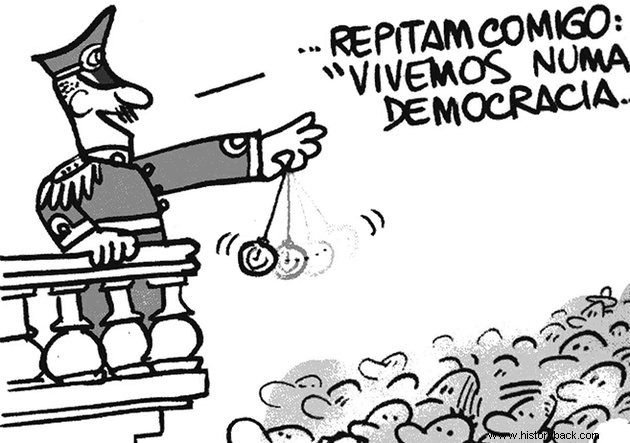The totalitarian regimes are based on a centralizing, undemocratic and authoritarian state.
These governments emerged after the First World War (1914-1918) in several European countries from the crisis of capitalism and liberalism.
Abstract
Totalitarianism was a conservative reaction to democracy and political and economic liberalism. So, after the disaster of World War I, the idea arose that governments had to be strong to be effective.
It would be up to the citizens to follow in the footsteps of a charismatic leader who would be in charge of conducting national policy. Political parties should not exist, as they were the expression of discord.
These ideas were defended by the right, but Josef Stalin, in the Soviet Union, used totalitarianism in order to implant socialism.

The characteristics of totalitarianism are:
- Centralized government
- Extreme nationalism
- Anti-liberalism
- Military
- Military Youth Organizations
- Worship of the leader
- Single party
- Territorial expansionism
Origin of totalitarian states
After the First World War (1914-1918), liberal democracies fell into disrepute. Political parties, elections, direct voting, all this was pointed out by sectors of the right as the reasons for the conflict and the economic crisis.
There are voices that defend the end of liberal democracy and the implementation of a system where power would be in the hands of a few. Thus, in the face of the economic and political crisis, totalitarian ideas gained ground.
This was the case in Italy where Benito Mussolini claimed that the best way to solve the country's problems was the creation of a totalitarian regime.
It was also the transformation that the Soviet government underwent after Lenin's death, when the regime focused on the figure of Stalin. In this way, those who did not conform to Stalinist guidelines were persecuted and the decision-making power of the soviets was diminished.
Main totalitarian regimes
Here are the main totalitarian regimes that emerged in Europe in the 20th century:
Soviet Stalinism
With the Russian revolution of 1917 and after the death of Lenin, Stalinism began in the USSR with the power concentrated in the hands of Josef Stalin.
Stalin eliminated his opponents and rose through the ranks until he became the most important figure in the Soviet Union. It was one of the leftist totalitarian regimes that lasted from 1927 to 1953, ending civil liberties in the country.
Stalin transformed the Soviet Union from an agrarian country to an industrial power in a decade. However, this was done on the basis of land collectivizations and the forced labor of dissidents in the Gulag, a special prison for those committing political crimes.
See also:StalinismFascism
Italian fascism began with Benito Mussolini in 1919, with the founding of the National Fascist Party (PNF).
With an anti-communist and anti-democratic inspiration, the fascists entered the Italian government after "The March on Rome", in 1922. In front of the large crowd that supported him, Mussolini was invited to be head of government by King Victor Emmanuel III.
Mussolini gradually incorporated the fascist party into the government, appointing ministers from the fascist members, reforming education and attracting supporters among the marginalized.
Mussolini's fascist government was the first right-wing totalitarian regime that emerged in Europe and did not end until July 1945.
See also:FascismNazism
Hitler was the main figure of the Nazi regime that was established in Germany from 1933. Inspired by Italian fascism, Nazism also added to its program the superiority of the Aryan race over the others.
The Nazi government promoted anti-Semitic ideas, mainly persecuting and exterminating Jews. However, it also physically eliminated the physically and intellectually disabled, communists, religious people.
To count on the support of the German army, Nazism propagated the idea of "living space". Initially, this included Germanic peoples such as Austrians and Germans who lived in Czechoslovakia, and would expand to Eastern Europe. The territorial expansion of Nazi Germany would eventually start World War II.
Nazism ended in 1945 with the suicide of Adolf Hitler and the end of World War II.
See also:NazismRegimes of totalitarian inspiration
Despite having been dictatorships, Salazarism and Francoism cannot be considered totalitarian regimes. The big difference, in the two cases, was the considerable role that the Catholic religion played, something that we do not observe in Italian fascism or in German Nazism.
Salazarism
Salazarism was a dictatorial regime inspired by fascist ideals that prevailed in Portugal under the leadership of Antônio de Oliveira Salazar from the New Constitution, established in 1933.
Called the “New State”, Salazar’s motto was “God, Fatherland and Family ” and was one of the longest dictatorships of the 20th century. The population elected the president of the Republic, usually in fraudulent elections, but Salazar was the all-powerful president of the Council of Ministers.
Salazar's policy isolated Portugal from the international scene, ended freedom of expression and continued colonialism in Africa.
The regime only ended with the Revolution of April 25, 1974, called the Carnation Revolution.
See also:Salazarism in PortugalFrancism
General Francisco Franco, inspired by nationalism, rebelled against the democratic government of President Manuel Azaña Díaz and plunged Spain into the Civil War (1936-1939).
The republicans were defeated and many went into exile in France and Mexico. Meanwhile, Franco establishes an anti-democratic and nationalist regime in Spain that encompasses all aspects of society and privileges the Catholic religion.
In the 1970s, the Franco regime would pass to democracy, in a transition led by then-Prince Juan Carlos, who articulated with the exiled leaders on the return of democracy.
The Franco regime would only end with the death of Franco, in 1975.
See also:Francoism in SpainTotalitarian regime today
Currently, the only totalitarian regime that survives is that of North Korea, which has the same characteristics mentioned above.
There are states that have dictatorial aspects like Cuba, Venezuela and China, but they cannot be considered totalitarian.
There are more texts on the subject for you :
- Totalitarianism and Authoritarianism
- Totalitarianism
- History's Greatest Dictators
